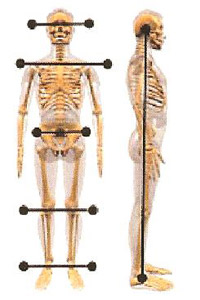Signs and Symptoms of TMD
 Pain or dysfunction of the head and neck is a very common condition and one that might be resolved very simply or might be very complex and frustrating to treat, depending upon the circumstances.
Pain or dysfunction of the head and neck is a very common condition and one that might be resolved very simply or might be very complex and frustrating to treat, depending upon the circumstances.
The bite can be a factor in many types of pain or functional problems because of the inter-relationship of the overall musculoskeletal system. Since there is a relationship between the teeth, jaw joints, head and neck muscles, and head posture, a problem in any one of these areas may affect others. These can include painful clicking or popping of the jaw joint, various types of head and neck pain, swallowing problems, postural problems, and excessive snoring or sleep apnea, to mention a few.
 If it is suspected that you suffer from this type of problem, the neuromuscular dentist may ask you if you have any of the symptoms shown in the table below. In addition, they will be looking for a number of signs in your posture, the appearance and condition of your teeth, and your existing bite that might aid in the diagnosis. An imperfect bite often plays a significant role in these conditions and the dentist experienced in treating them may resolve the problem alone. However, diagnosing these problems can be very difficult at times and may require the collective efforts of your dentist and other health care professionals. These may include your doctor, an ear, nose and throat specialist, physical therapist, chiropractor or massage therapist.
If it is suspected that you suffer from this type of problem, the neuromuscular dentist may ask you if you have any of the symptoms shown in the table below. In addition, they will be looking for a number of signs in your posture, the appearance and condition of your teeth, and your existing bite that might aid in the diagnosis. An imperfect bite often plays a significant role in these conditions and the dentist experienced in treating them may resolve the problem alone. However, diagnosing these problems can be very difficult at times and may require the collective efforts of your dentist and other health care professionals. These may include your doctor, an ear, nose and throat specialist, physical therapist, chiropractor or massage therapist.
Musculoskeletal signs and symptoms
Do you suffer from any of these?
- Headaches
- Clenching or grinding
- Jaw joint pain
- Facial pain
- Jaw joint noises or clicking
- Sensitive teeth
- Limited mouth opening
- Chewing difficulties
- Ear congestion
- Neck pain
- Dizziness
- Postural problems
- Ringing in the ears
- Tingling of the fingertips
- Difficulty swallowing
- Hot and cold sensitivity of teeth
- Loose teeth
- Nervousness or Insomnia
The Dentist’s Diagnosis
The neuromuscular dentist will consider all of the information gathered by taking your history and doing a physical examination of your teeth, head and neck. When indicated, they may conduct a series of tests using non-invasive electronic instruments.


Data from these tests will indicate to your dentist whether your bite is a major contributing factor to your problem and will help rule in or rule out your bite as the cause of, or major component of, your condition. If these tests show that your habitual bite is a probable cause of your condition or pain, the neuromuscular dentist then identifies a jaw position determined by the relaxed state of the muscles. This jaw position and the corresponding new bite is called neuromuscular occlusion.



